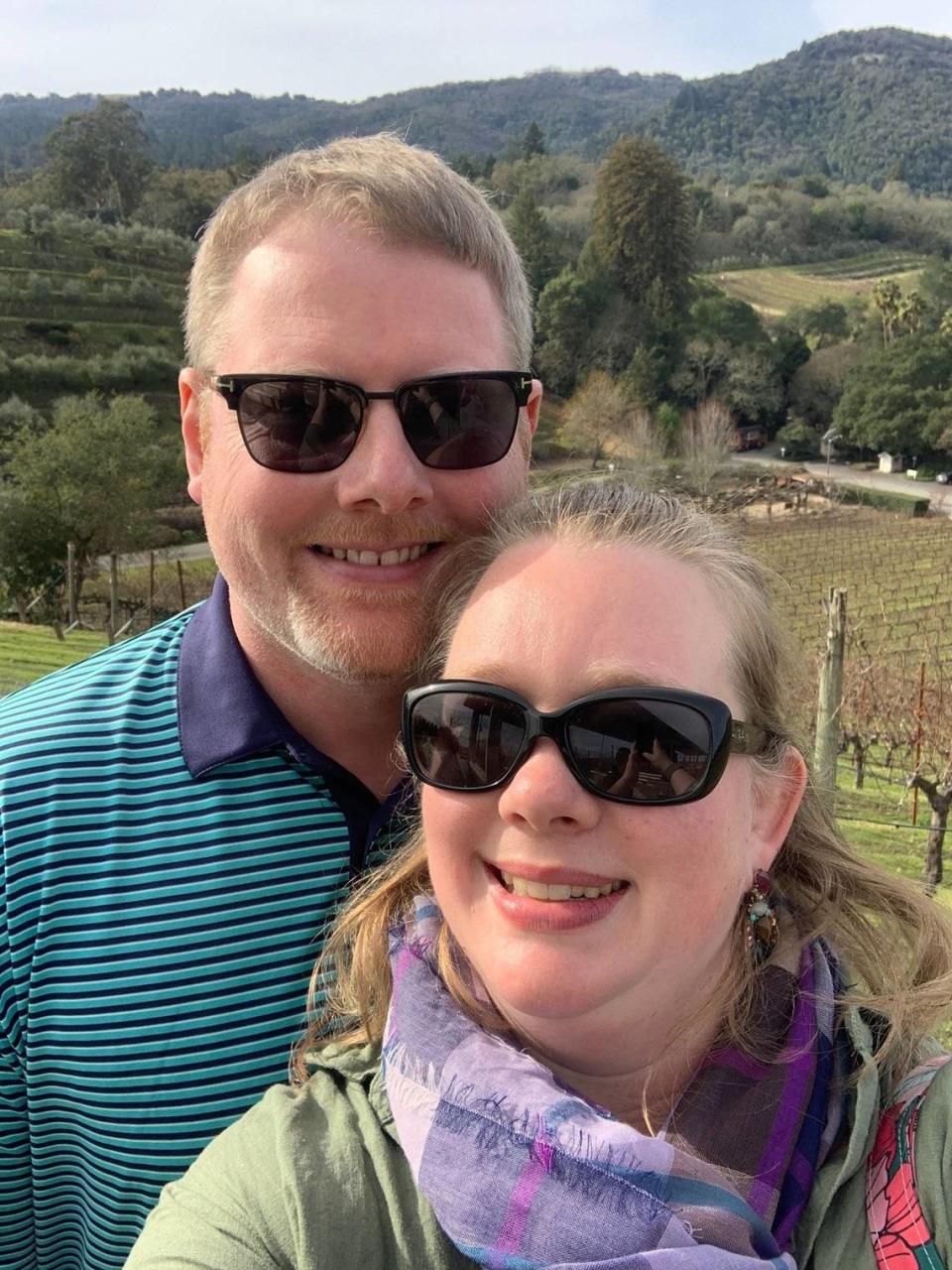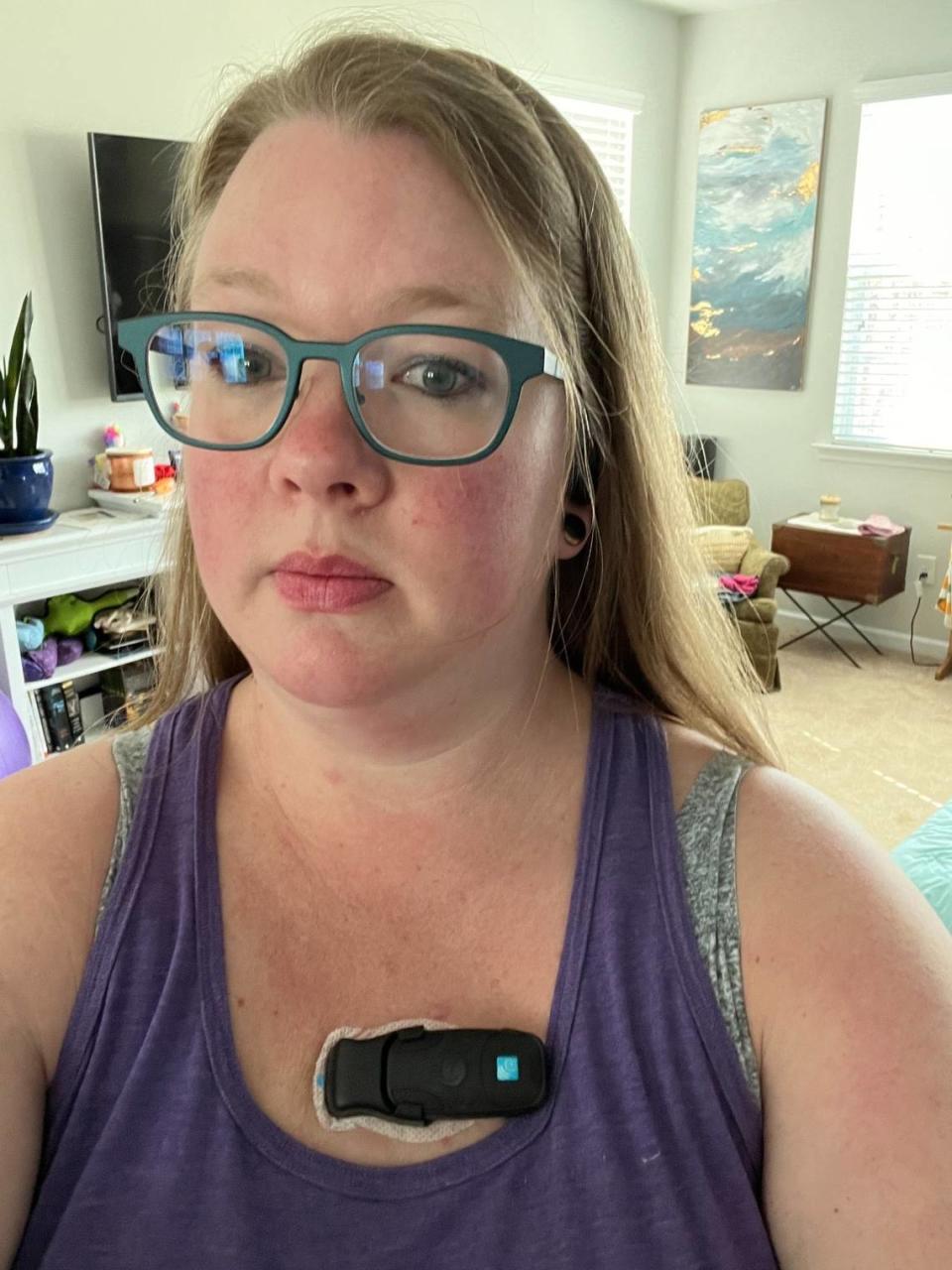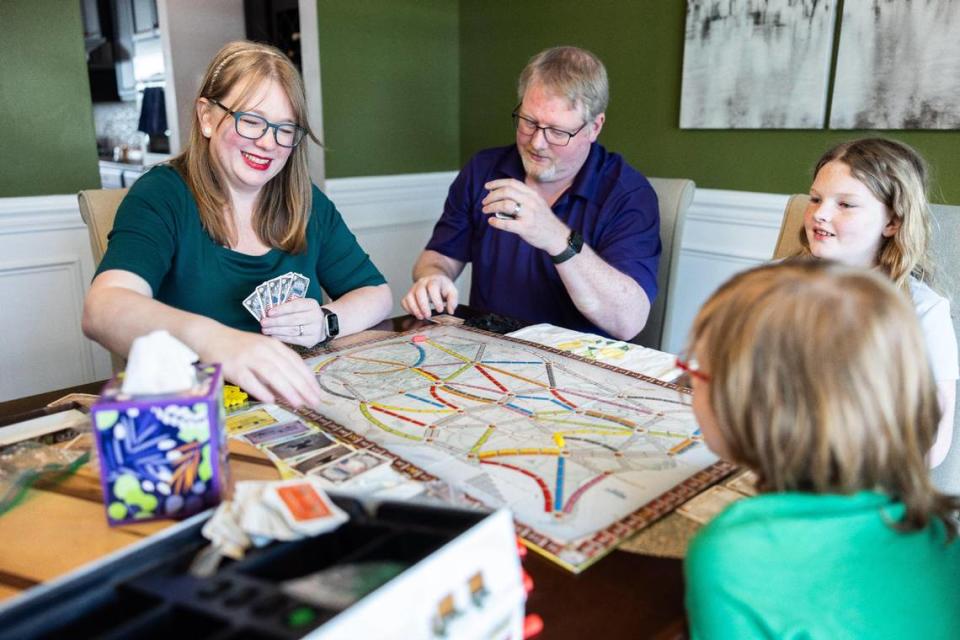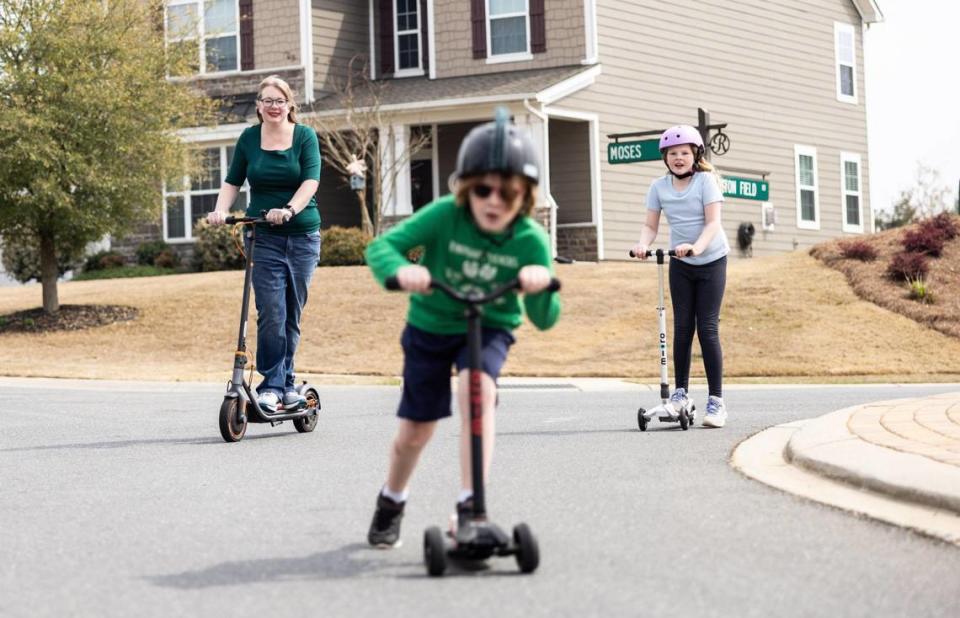She’s lost friends, a job and her identity over long COVID. Will she ever be ‘Old Me’ again?
When Mary Eggert is asked by friends, neighbors, relatives — or by anyone, really — to describe what her experience with long COVID has been like, she’ll almost always mention the fatigue being so overwhelming that she has to take a nap every day.
And then, she can usually predict the response.
“The first thing most people say is, ‘I wish I could take a nap every day,’” says the 40-year-old Indian Land, South Carolina mother of two. “And I know they’re just trying to relate, but I want to be like, ‘We are not the same. I don’t want to have a nap every day. I have to have a nap every day. If I don’t take a nap every day, it is so much worse.’ This wasn’t a choice I made. ... I guess I’m living someone’s best life because I take a nap every day. But —”
She lets out a heavy sigh before finishing the thought.
“— sometimes it just feels like they are fundamentally not understanding the severity of what I’m talking about.”
In Eggert’s case, this is how severe things have gotten since she was diagnosed in December 2022 with long COVID, which is characterized by symptoms lasting four weeks or more (and often much longer): She’s no longer gainfully employed, having given up last year on being physically able to perform a job she loved. She’s lost the once-sure-handed grip she had on being a fully engaged parent to her now-6- and 9-year-old kids. She’s lost a good deal of her social life; in some cases, she has even lost friends.
She has, in fact, lost a great deal of her identity, which she says now revolves around an illness that has dominated her and her family’s life for coming up on two years now.
It is an existence, she says, that is literally but also figuratively exhausting.
“I mean, I don’t want to make every interaction I have about me having long COVID,” says Eggert, who is among the 6% of U.S. adults living with the condition. “I don’t want that to be my entire personality, every time I see someone. Sometimes I just want to be like, ‘Yes. My lipstick is pretty! Let’s talk about that.’ So ... I don’t know. I haven’t figured out the right answer on the balance on how to talk about it.
“But I do try to be probably more open than I normally would, because it is an invisible illness, and I want people to understand it.”
At the same time, she recognizes that some people aren’t going to believe she’s actually sick at all.
‘It was a really terrifying time’
Mary and Adam Eggert moved themselves and their toddler-daughter Aurora to the Charlotte area from Portland, Maine in 2016, away from the snow and toward the barbecue.
They settled across the state line in a pleasant South Carolina subdivision and would soon add a son, Griffin, to the mix. Adam continued remotely with the same disability reinsurance firm he’d been with in Maine, while Mary worked as a physical therapist at the old Springs Memorial Hospital in Lancaster and then the new Medical University of South Carolina facility that replaced it in 2019.
When they weren’t working, they were chasing their kids around the neighborhood, or playing games with them in the living room, or making delightful messes with them in the kitchen. When they weren’t spending time with the kids, they were hanging with friends, or dreaming up fun travel plans, or tackling some sort of ambitious house project or another — redoing the pantry, bumping out the patio, laying mulch in the flowerbeds.

And when the whole family got COVID in July of 2022, they figured it was just a speed bump.
It was not, in their minds, an insignificant one. Aurora and Griffin were asymptomatic, but Mom and Dad were miserable and lacked the energy to keep their very active kids sufficiently entertained. So they hoped for a relatively speedy recovery.
Adam got his. Mary did not.
Although her flu-like symptoms went away in a reasonable amount of time, and although her congestion and cough cleared up within about two weeks, she continued to suffer from crippling exhaustion virtually all day long into late August, along with shortness of breath, dizziness and an elevated heart rate from doing something as simple as trying to walk to the end of the street. By September, she also was having brain fog characterized by difficulty staying focused, bouts of confusion, even struggling to remember a simple word to complete a simple thought.
She would have returned to work if she could — after all, she was out of sick days and paid time off so she wasn’t bringing in any income, and while her boss had been accommodating she knew they couldn’t hold her job for her forever.
It wasn’t just that she didn’t have the energy to work, though. She didn’t have the energy to do much of anything.
Some days, she’d empty the dishwasher and need to lie down for an hour to recover. Some nights, she’d stand at the bottom of the stairs leading up to their bedroom and hesitate to try climbing them for fear of not being able to make it all the way to the top.
Meanwhile, everyone in her life wanted to know why she was barely leaving the house.
“There were a lot of people who thought COVID was a hoax,” Mary says, matter-of-factly, so she routinely found herself being met with thinly veiled skepticism at best and — at worst — by people who flat-out would try to persuade her that she had pretty much anything except long COVID.
She could pretty easily shrug off the skepticism, if she had to. But she couldn’t shake her worsening symptoms.
“It was terrifying,” Mary says, “because you’re going, OK, well, it’s been three weeks. ... It’s been six weeks. ... This isn’t getting better. You know, it’s too soon to say ‘long COVID.’ But it’s been long enough that we’re, like, whispering it softly in the background. And you just — you don’t know. Like, is it long COVID? If so, what does that mean? Is this just for a few months? If so, how are we getting through them? Is this forever? If so, what will the rest of my life look like now?
“It was really a terrifying time.”
Little did she know then that the situation could — and would — get much worse.
Doing a lot of fancy guesswork
In September 2022, three months after Mary originally was felled by COVID, her primary-care physician referred her to Atrium Health’s then-brand-new program for treating and streamlining care for patients with what it referred to as “Post-Acute COVID-19 syndrome.”
The wait to see someone lasted another three months. She finally got in for an appointment in December.
In the back of her mind, she harbored a little bit of hope that she had been referred to the wrong place. “You’re like, ‘Oh, maybe it’s not really this. Maybe it’s just this other really easily fixable thing,’” Mary remembers thinking. But the clinician she was assigned to — physician assistant Kent Truslow — was not at all uncertain about his diagnosis.
Mary had long COVID.
On the one hand, she actually felt a little bit of a weight lifted. She was grateful that someone had taken her seriously. “But it’s also just heartbreaking,” she says, “to be like, ‘Aw, crap. It is this. This is what’s happening.’”
Truslow says the presence of comorbidities including diabetes, asthma and being overweight might have made Mary more susceptible to acquiring it, and to experiencing her specific symptoms. In terms of his plan of attack with Mary, he says, simply, “we focused on controlling the things we could control, working with her primary (care doctor).”
But Truslow knew they were basically just doing a lot of fancy guesswork.
According to the National Institutes of Health, scientists just don’t know for sure what causes long COVID, and the NIH asserts that there is no specific treatment yet.
“You don’t want to lie to people,” Truslow says. “You don’t want to try to get their hopes up just to get their hopes up for a period of time. Because there’s a lot of unknown. So that’s the approach I take is, ‘Hey, we don’t know everything yet. This is a new disease — somewhat of a new process that long COVID has presented us with — and we’re still figuring it out.’”

One of the first things Truslow did was refer Mary to a pain management doctor who in January 2023 would start her on a series of injections called stellate ganglion blocks, which are designed to reset the sympathetic nervous system.
The initial one made an “incredible” difference, she says, taking her “from being maybe 20% of original me to 50%,” but only under ideal conditions, only for intervals, and only to see that number decrease with fatigue. Then the next two shots yielded less-dramatic improvements. She could participate more in her husband’s and kids’ lives, but she still needed breaks, needed naps, needed lots of rest to conserve energy before any critical family activity, then needed lots of recovery afterward.
She definitely didn’t feel it was wise to spend anywhere close to a full day transitioning from squatting or kneeling to standing, something she’d have to do constantly as a physical therapist.
Which crushed her.
“Mary was really grappling with the fact that she probably wasn’t gonna go back to work,” Adam says, “and because we were six months in at that point, I recommended applying for Social Security Disability (Insurance), just to get it in the system. ... I work in the disability insurance industry, so for me it was a precaution more than anything else — to get it going sooner rather than later — especially given the timeframe that they take to approve claims.
“But that was a really hard pill for her to swallow. It made her very down on the prospects for living a normal life, or what she perceived as a normal life. To her, it felt a lot like admitting defeat.”
‘I’m inadequate. I’m failing my kids.’
Mary cried almost every day for almost two months over the prospect of having to leave her job.
After she finally did, though, on May 10 of last year, she actually felt a little bit of a weight lifted again. She didn’t feel like she was stringing her boss along anymore. She didn’t feel any more of that guilt. By summer, Adam says, “we were able to find a really good groove” as Mary settled into her new normal. As the whole family did.
But another big blow-up was brewing.
Amid all of Mary’s challenges, their son Griffin and their daughter Aurora were both diagnosed with ADHD. So over the summer, Adam and Mary opted to transition them to new schools that they thought could better meet the kids’ needs.
It wasn’t the smoothest of transitions — especially as it pertained to Griffin, whose condition is more severe.
“We were struggling a lot with trying to navigate, OK, I need to get all of these doctors’ appointments for him, and deal with the school, and it suddenly felt like we were in this crisis situation, like, ‘Oh, this is not working,’ in a very big way,” Mary recalls. “I knew, ‘For the health and well-being of my kid, I should be doing these four strategies (for supporting) him,’ but I also knew, ‘I can do one of these. That is all I have in me.’ And I could see that ‘Old Me’ would have been able to do it, but ‘Current Me’ just can’t meet that in the same way. ...
“But it’s hard when you’re in that moment to not be like, ‘I’m inadequate. I’m failing my kids.’”
By this point, too, because Mary’s condition had forced the couple to repeatedly decline invitations for social interactions with friends and neighbors, many of them had stopped reaching out altogether.
Her anxiety over all of this triggered a relapse of her worst symptoms, as well as a bout of something she hadn’t experienced since she injured her knee in college — depression.
And collectively, the Eggerts’ downward spiral continued in October, when Adam tore his Achilles’ tendon upon tripping and falling while changing out the wheels on his rolling office chair. He had surgery to repair it the day before Halloween and wasn’t able to walk without crutches for much of November, leaving him unable to shoulder most of the added burdens he’d taken on since Mary had gotten sick.
Yet there was a silver lining.
Around the same time Adam injured himself, Mary had her fourth (and, for the foreseeable future, final) stellate ganglion block — which “maybe gave me a 10% boost” — and also started on a selective serotonin reuptake inhibitor that wound up alleviating her depression but also inadvertently increased her energy levels a little.

Mary was still a long way off from 100%. And today, nearly five months later, she says she’s still struggling with a little of the brain fog, still coping with a lot of the exhaustion and fatigue, and still completely not sure what the answer is to this question:
Will she ever feel completely well again?
Tuning out noise — and choosing joy
There are a variety of significant ongoing efforts to better understand the underlying causes of Long Covid and how to treat sufferers of it.
The very long list of examples includes an analysis of studies published last November by Cambridge University Press that found people who’d had three doses of a COVID vaccine were 68.7% less likely to develop long COVID compared with those who were unvaccinated; a small study published in the American Journal of Emergency Medicine in December that found three patients with long COVID made sudden, total recoveries after being given a monoclonal antibody cocktail; and the commencement this month of two NIH clinical trials aimed at testing three new treatments for adults with autonomic nervous system dysfunction from long COVID.
At the same time, there are powerful voices in opposition.
In fact, on the same day in December 2022 that Atrium physician assistant Kent Truslow diagnosed Mary, The Wall Street Journal published an op-ed penned by Johns Hopkins University surgeon and public policy researcher Marty Makary under the headline “The Exaggeration of Long COVID: Lingering symptoms after a respiratory infection are common. Most cases are too mild to worry about.”
Just three weeks ago, on the second annual International Long COVID Awareness Day, the chief health officer for the state of Queensland in Australia publicly argued the term “Long Covid” should stop being used. In doing so, he pointed to new research that found long-term symptoms associated with Covid are the same as other viral infections and therefore could lead to a potentially detrimental hyper-vigilance among sufferers.
The latter news prompted The New York Post to write op-eds announcing “Long Covid is fake!” — although it’s worth noting that the Australian official explicitly said of the condition, “We’re absolutely saying that it does exist.”
Truslow, for one, says he understands why controversy exists.
“I mean, when you can’t quantify a disease with a blood test, with some kind of procedure, a lot of people say, ‘Well, then you’re making it up. This is all in your head. You just need counseling. Maybe go see a psychiatrist,’” he says. “Even in the medical community. There are medical providers out there who are not as in tune with this, or refuse to believe that someone can be this sick for this long and not have any biomarkers or physical-exam findings that support their feelings. ...
“So yeah, the stigma’s certainly out there. But I think there’s more awareness for it, and hopefully over time there will continue to be.”
Meanwhile, the Eggerts are trying their best to tune out that kind of external noise and to stay tuned in to all of the things that help manage, mitigate, or minimize Mary’s symptoms so she can stay as engaged as possible with her family.
“My husband and I choose joy,” Mary says. “That’s where I get my hope, you know? I’ve seen improvements. I’m hopeful that there’s more out there, and if there aren’t, well, at least my kids know they’re loved. I’m showing up for them differently, but I’m still showing up for them. My husband loves me in a way that I cannot fathom, and I love him. This isn’t the journey we picked, but we’re still doing it together.”
Adds Adam: “And if at some point they come up with some miracle drug that —” he snaps his fingers “— turns her back to her old self, that’ll be an amazing change for us.”
“We will accept it,” she says. Mary’s mouth curls into a smile, which then quickly fades.
“I don’t know. It’s harder for me emotionally to keep being like, ‘I can’t wait until things are normal!’ I don’t want to live my life acting like this isn’t my life, or like I’m waiting for my life to begin again. This is it right now. This is what I’ve got. If my Long Covid chapter closes later and a new chapter opens, then that’s gonna be awesome. But I’m not waiting for it.
“Because life is happening now — and I want to keep happening with it.”


